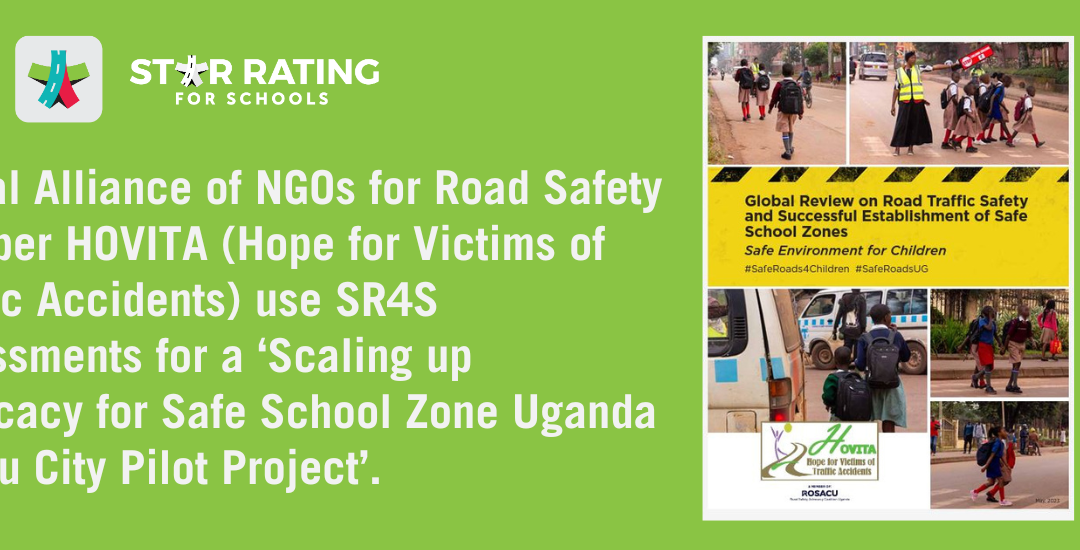Page 14: 3.2.1 Scaling Up Advocacy For Safe School Zone Uganda- Gulu City Pilot Project
Hope for Victims of Traffic Accidents (HOVITA), with support from Global Road Safety Partnership (GRSP) and Global Health Advocacy Incubator (GHAI) (under the Project SCALING UP ADVOCACY FOR SAFE SCHOOL ZONE Uganda) carried out a Road Safety assessment/situational analysis for 2 Schools that is Gulu primary school and Mother Angelliotta primary school in Gulu city 2021.
The assessment was aimed at helping HOVITA to make recommendations for improving safety of roads around schools, raising awareness among children, parents, teachers and school community, and advocate for development and implementation of safe school zones to the relevant government Ministries, Departments and Agencies (MDAs) and Gulu City.
The assessment was achieved through data collection, assessment and analysis; key informant interviews; focus group discussion and school zone road safety assessment using the iRAP Star Rating for Schools (SR4S) Methodology. The tools used by the team during the exercise included questionnaires, SR4S data form, audio recordings, note books, digital cameras and tape measures. The data was assessed and analyzed as per the iRAP Star Rating for Schools (SR4S) guide.
The HOVITA team established the following general safety concerns or risks:
- There are inadequate school zone signage to moderate trac speeds.
- There are no access road signage and school information signage on most of the roads to alert and guide motorists to make correct and quick decisions.
- There are inadequate designated crossing points (zebra crossings) for the children/ pedestrians and speed management in school zones.
- Some schools have no crossing supervisor to help control children crossing movements. All schools have no crossing supervisor signage.
- Most of the roads are not marked and where the markings exist, they are faded.
- There are no junction signs and yield signs on most of the approaches to road junctions.
- There are inadequate speed control or calming measures (i.e., Humps, rumble strips) on all road sections within the school zone areas.
- Where the humps and rumble strips exist, they are not marked hence not easily visible to road users.
- There is insucient speed limit signage in school zones.
- There are no walkways/sidewalks on most of the roads within the school zones.
- There are open/unprotected side drains on most of the roads, which is very hazardous to children.
- Overgrown roadside shrubs obstruct visibility.
- Uncovered manholes on the pedestrian walkways.
- No Road signs for Blind, deaf and disabled children
The review thus makes the following recommendations:
- Designate school zones and provide adequate school zone signage to help moderate trac speeds which can reduce injury severity.
- Install adequate access road signage and visible school information signage along all roads at appropriate locations to guide, alert and warn motorists make correct and quick decisions.
- Provide designated raised and properly marked crossings points (zebra crossings) and install appropriate speed regulation signage reinforced with speed control measures in school zones.
- Provide at least two (2) crossing supervisors per school to guide and help control children/pedestrian crossing movements mostly at peak school hours.
- Install adequate speed control measures (rumble strips, humps) in school zones and built-up areas with high pedestrian density and junctions appropriately to enforce speed reduction.
- Cover all manholes on the pedestrian walkways.
- Install appropriate speed limit signage to adequately guide and regulate drivers through the school zones.
- Provide sidewalks for the children along the roadside adjacent to the school.
- Clear the roadside environment of shrubs to enhance visibility
- Enhance awareness raising, sensitisation and routine road safety education for school children, teachers, parents and school community including all road users.
- Conduct training for school teachers on how to convey road safety points to children at different ages.
- Enhance advocacy for development and implementation of safe school zones policies and regulations.
This report refers first to the general road safety concerns, and then gives the findings and recommendations for the concerns at specific points along the inspected road sections around school zones.
The assessment established several road safety concerns as presented in the foregoing, the school zone road safety risk is generally rated high (essential) on all road section based on the findings.
Awareness raising, sensitization and routine road safety education for school children, training for school teachers on how to convey road safety points to children at different ages and inclusion of road safety in the education school curriculum are very important if the vision of having a world where children travel safely to and from school is to be realized.
The advocacy for development and implementation of safe school zones policies and regulations should be enhanced. School zones should be appointed at least 100m on either side from the school main entrance. Vehicle operating speeds are expected to increase if the roads are rehabilitated hence designs should be audited for safety before implementation. School zones should be appointed at least 50m on either side from the school main entrance and on all approaches and junctions within a radius of 50m from the school. There is need to continuously monitor and evaluate the outcomes of improved areas. However, there is no systematic process for registering number of pupils/students suffering from road crashes when travelling to/from school apart from a few that may be reported to Police which makes the evaluation difficult.

